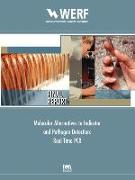- Start
- Molecular Alternatives to Indicator and Pathogen Detection
Molecular Alternatives to Indicator and Pathogen Detection
Angebote / Angebote:
Microbial quality of water is a prime public health concern in today's world. To protect public health, the World Health Organization and the U.S. Environmental Protection Agency have established microbial pollution indicator standards and recommended routine monitoring of water for both total and fecal coliforms (Dufour, 1984, U.S. EPA 1986, 1994, WHO 1993). However, the adequacy of current water quality standards to indicate the presence or absence of human pathogens is still questionable. For example, human viruses are more resistant to sewage treatment processes and environmental conditions than bacterial indicators and therefore may pose a substantial threat. It is now recognized that the absence, or a low concentration, of indicator organisms in water may not adequately reflect the absence of human viruses. In our previous study of southern California coastal waters, we found over 30% of coastal waters tested contained human viruses, and the presence of these viruses did not correlate with an elevated level of bacterial indicators (Jiang et al. 2000). The goal of this research is to develop and validate a molecular method for rapid and specific detection of microbial contaminants including human viruses and bacterial indicators in treated sewage effluents and receiving waters. Research Outcomes An extensive search and review of current state of technology for molecular alternatives to indicator and viral pathogen detection was conducted. The results indicate that although real-time PCR methods have been widely applied in the clinical research for detection of human viruses, environmental application of this method is very limited. In addition, there is an urgent need for a method for efficient concentration and purification of human viruses in complex environmental matrixes. During this study, we have designed, tested and optimized real-time quantitative PCR method using specific and degenerate primers and probes targeting at adenoviruses and enterococci, respectively. Experimental testing of real time PCR primers and probes for adenoviruses demonstrated reproducible results at efficiency greater than 90% over a 5-log dynamic range of target concentration. The enterococci real time PCR was efficient at 99% of the time and over a 7-log dynamic range of target concentration. Application of these methods to sewage effluents and coastal waters demonstrated that real-time PCR methods are more sensitive than culturing methods at detection of targets, suggesting a great potential for real-time quantification of microbial contaminants in environments. However, real-time PCR based method, like other genome based detection technology, overestimates the concentration of infectious viral concentration in the environment. In addition to the method development for real-time PCR detection, we have also sampled and isolated human adenoviruses from Newport Bay, California using human embryonic kidney cells, 293A. Cloning and sequencing of selective environmental adenovirus hexon gene suggested that most of the viruses recovered from the environment belong to adenovirus serotype 40 (66%). This result is in agreement with clinical data on the load of viral shedding in feces. Since adenovirus serotypes 40 and 41 are the major cause of childhood diarrhea, the result of this investigation indicates the importance of monitoring water for viral quality. Comparison of four different tissue culture cell lines for their sensitivities to adenoviruses infection has demonstrated that the genetically engineered 293A cells are the most efficient at recovery of adenoviruses 40. This result is a significant contribution to our ability to assay for infectious adenoviruses in environmental samples.
Folgt in ca. 15 Arbeitstagen
